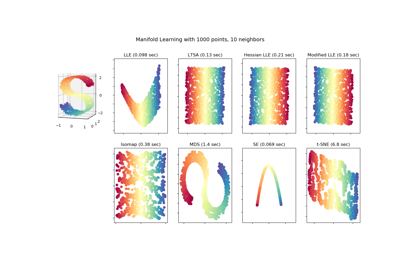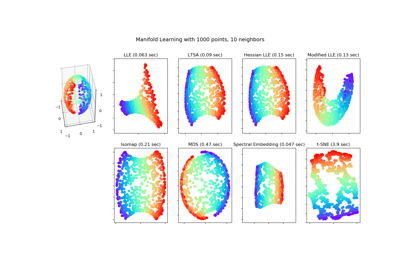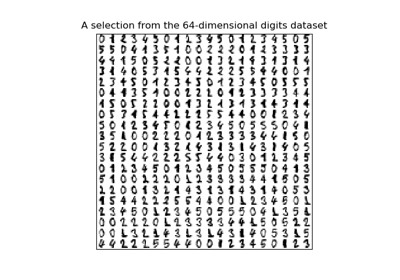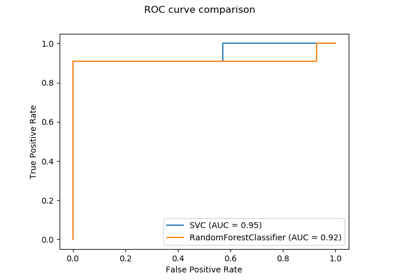sklearn.manifold.Isomap¶
-
class
sklearn.manifold.Isomap(n_neighbors=5, n_components=2, eigen_solver='auto', tol=0, max_iter=None, path_method='auto', neighbors_algorithm='auto', n_jobs=None, metric='minkowski', p=2, metric_params=None)[source]¶ Isomap Embedding
Non-linear dimensionality reduction through Isometric Mapping
Read more in the User Guide.
- Parameters
- n_neighborsinteger
number of neighbors to consider for each point.
- n_componentsinteger
number of coordinates for the manifold
- eigen_solver[‘auto’|’arpack’|’dense’]
‘auto’ : Attempt to choose the most efficient solver for the given problem.
‘arpack’ : Use Arnoldi decomposition to find the eigenvalues and eigenvectors.
‘dense’ : Use a direct solver (i.e. LAPACK) for the eigenvalue decomposition.
- tolfloat
Convergence tolerance passed to arpack or lobpcg. not used if eigen_solver == ‘dense’.
- max_iterinteger
Maximum number of iterations for the arpack solver. not used if eigen_solver == ‘dense’.
- path_methodstring [‘auto’|’FW’|’D’]
Method to use in finding shortest path.
‘auto’ : attempt to choose the best algorithm automatically.
‘FW’ : Floyd-Warshall algorithm.
‘D’ : Dijkstra’s algorithm.
- neighbors_algorithmstring [‘auto’|’brute’|’kd_tree’|’ball_tree’]
Algorithm to use for nearest neighbors search, passed to neighbors.NearestNeighbors instance.
- n_jobsint or None, default=None
The number of parallel jobs to run.
Nonemeans 1 unless in ajoblib.parallel_backendcontext.-1means using all processors. See Glossary for more details.- metricstring, or callable, default=”minkowski”
The metric to use when calculating distance between instances in a feature array. If metric is a string or callable, it must be one of the options allowed by
sklearn.metrics.pairwise_distancesfor its metric parameter. If metric is “precomputed”, X is assumed to be a distance matrix and must be square. X may be a Glossary.New in version 0.22.
- pint, default=2
Parameter for the Minkowski metric from sklearn.metrics.pairwise.pairwise_distances. When p = 1, this is equivalent to using manhattan_distance (l1), and euclidean_distance (l2) for p = 2. For arbitrary p, minkowski_distance (l_p) is used.
New in version 0.22.
- metric_paramsdict, default=None
Additional keyword arguments for the metric function.
New in version 0.22.
- Attributes
- embedding_array-like, shape (n_samples, n_components)
Stores the embedding vectors.
- kernel_pca_object
KernelPCAobject used to implement the embedding.- nbrs_sklearn.neighbors.NearestNeighbors instance
Stores nearest neighbors instance, including BallTree or KDtree if applicable.
- dist_matrix_array-like, shape (n_samples, n_samples)
Stores the geodesic distance matrix of training data.
References
- R7f4d308f5054-1
Tenenbaum, J.B.; De Silva, V.; & Langford, J.C. A global geometric framework for nonlinear dimensionality reduction. Science 290 (5500)
Examples
>>> from sklearn.datasets import load_digits >>> from sklearn.manifold import Isomap >>> X, _ = load_digits(return_X_y=True) >>> X.shape (1797, 64) >>> embedding = Isomap(n_components=2) >>> X_transformed = embedding.fit_transform(X[:100]) >>> X_transformed.shape (100, 2)
Methods
fit(self, X[, y])Compute the embedding vectors for data X
fit_transform(self, X[, y])Fit the model from data in X and transform X.
get_params(self[, deep])Get parameters for this estimator.
reconstruction_error(self)Compute the reconstruction error for the embedding.
set_params(self, \*\*params)Set the parameters of this estimator.
transform(self, X)Transform X.
-
__init__(self, n_neighbors=5, n_components=2, eigen_solver='auto', tol=0, max_iter=None, path_method='auto', neighbors_algorithm='auto', n_jobs=None, metric='minkowski', p=2, metric_params=None)[source]¶ Initialize self. See help(type(self)) for accurate signature.
-
fit(self, X, y=None)[source]¶ Compute the embedding vectors for data X
- Parameters
- X{array-like, sparse graph, BallTree, KDTree, NearestNeighbors}
Sample data, shape = (n_samples, n_features), in the form of a numpy array, sparse graph, precomputed tree, or NearestNeighbors object.
- yIgnored
- Returns
- selfreturns an instance of self.
-
fit_transform(self, X, y=None)[source]¶ Fit the model from data in X and transform X.
- Parameters
- X{array-like, sparse graph, BallTree, KDTree}
Training vector, where n_samples in the number of samples and n_features is the number of features.
- yIgnored
- Returns
- X_newarray-like, shape (n_samples, n_components)
-
get_params(self, deep=True)[source]¶ Get parameters for this estimator.
- Parameters
- deepbool, default=True
If True, will return the parameters for this estimator and contained subobjects that are estimators.
- Returns
- paramsmapping of string to any
Parameter names mapped to their values.
-
reconstruction_error(self)[source]¶ Compute the reconstruction error for the embedding.
- Returns
- reconstruction_errorfloat
Notes
The cost function of an isomap embedding is
E = frobenius_norm[K(D) - K(D_fit)] / n_samplesWhere D is the matrix of distances for the input data X, D_fit is the matrix of distances for the output embedding X_fit, and K is the isomap kernel:
K(D) = -0.5 * (I - 1/n_samples) * D^2 * (I - 1/n_samples)
-
set_params(self, **params)[source]¶ Set the parameters of this estimator.
The method works on simple estimators as well as on nested objects (such as pipelines). The latter have parameters of the form
<component>__<parameter>so that it’s possible to update each component of a nested object.- Parameters
- **paramsdict
Estimator parameters.
- Returns
- selfobject
Estimator instance.
-
transform(self, X)[source]¶ Transform X.
This is implemented by linking the points X into the graph of geodesic distances of the training data. First the
n_neighborsnearest neighbors of X are found in the training data, and from these the shortest geodesic distances from each point in X to each point in the training data are computed in order to construct the kernel. The embedding of X is the projection of this kernel onto the embedding vectors of the training set.- Parameters
- Xarray-like, shape (n_queries, n_features)
If neighbors_algorithm=’precomputed’, X is assumed to be a distance matrix or a sparse graph of shape (n_queries, n_samples_fit).
- Returns
- X_newarray-like, shape (n_queries, n_components)




